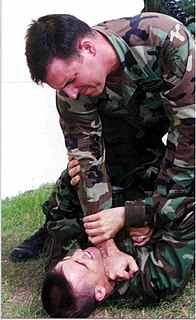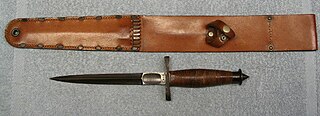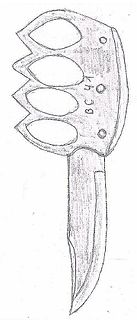Rex Applegate was an American military officer who worked for the Office of Strategic Services, where he trained Allied special forces personnel in close-quarters combat during World War II. He held the rank of colonel.

William Ewart Fairbairn was a British Royal Marine and police officer. He developed hand-to-hand combat methods for the Shanghai Police during the interwar period, as well as for the allied special forces during World War II. He created his own fighting system known as Defendu. Notably, this included innovative pistol shooting techniques and the development of the Fairbairn-Sykes Fighting Knife.
A smatchet is a short, heavy fighting knife 16.5 inches (42 cm) in overall length. It was designed by William E. Fairbairn during World War II.
World War II combatives are close quarters combat techniques, including hand-to-hand, advanced firearm point shooting methods, and weapons techniques that were taught to allied special forces in World War II by such famous instructors as Rex Applegate and William Ewart Fairbairn.

Close-quarters combat (CQC) or close-quarters battle (CQB) is a tactical situation that involves a physical fight with firearms involved between multiple combatants at quite short range. It can occur between military units, police/corrections officers and criminal elements, and in other similar situations. In warfare, it usually consists of units or teams of varying size engaging the target or attacking personnel with personal weapons within a distance of up to 100 meters, from proximity hand-to-hand combat to close-quarter target negotiation with usually automatic weapons. In the typical close combat scenario, the attackers try a very fast, violent takeover of a vehicle or structure controlled by the defenders, who usually have no easy method to withdraw. Because attacking and defending personnel, hostages/civilians, and friendly personnel can be closely intermingled, close-quarters combat demands a rapid assault and a precise implementation of lethal force. The operators need obvious, sufficient proficiency with their weapons, and the ability to make quick decisions in order to limit friendly casualties and raise the likelihood of operational success.

Gatka is a form of martial art associated primarily with the Sikhs of the Punjab and other related ethnic groups, such as Hindkowans. It is a style of stick-fighting, with wooden sticks intended to simulate swords. The Punjabi name, gatka, refers to the wooden stick used and this term might have originated as a diminutive of a Sanskrit word, gada, meaning "mace".
Close Quarters Combat System is a modern martial art developed by William E. Fairbairn and Eric A. Sykes prior to World War II. It is a hand-to-hand combat system based on practical experience mixed with Jujutsu and boxing that was developed to train the Shanghai Municipal Police, and was later taught in expanded form to Office of Strategic Services and Special Operations Executive members during World War II.

Hand-to-hand combat is a physical confrontation between two or more persons at short range that does not involve the use of ranged weapons. The phrase "hand-to-hand" may include use of melee weapons such as knives, swords, clubs, spears, axes, or improvised weapons such as entrenching tools. While the term hand-to-hand combat originally referred principally to engagements by combatants on the battlefield, it can also refer to any personal physical engagement by two or more people, including law enforcement officers, civilians, and criminals.

The Marine Corps Martial Arts Program is a combat system developed by the United States Marine Corps to combine existing and new hand-to-hand and close quarters combat techniques with morale and team-building functions and instruction in the warrior ethos. The program, which began in 2001, trains Marines in unarmed combat, edged weapons, weapons of opportunity, and rifle and bayonet techniques. It also stresses mental and character development, including the responsible use of force, leadership, and teamwork.

Combatives is the term for hand-to-hand combat training and techniques within the Army branch of the United States military.

A combat knife is a fighting knife designed solely for military use and primarily intended for hand-to-hand or close combat fighting.

The Fairbairn–Sykes fighting knife is a double-edged fighting knife resembling a dagger or poignard with a foil grip. It was developed by William Ewart Fairbairn and Eric Anthony Sykes in Shanghai based on ideas that the two men had while serving on the Shanghai Municipal Police in China before World War II.
Eric Anthony Sykes, born Eric Anthony Schwabe, was a soldier and firearms expert. He is most famous for his work with William E. Fairbairn in the development of the eponymous Fairbairn-Sykes Fighting Knife and modern British Close Quarters Battle (CQB) martial arts during World War II. Originally working for an import/export company selling weapons in East Asia, he claimed he volunteered for and served in the British Army as a sharpshooter on the Western Front during World War I. Returning to China in 1917, he joined the volunteer branch of the Shanghai Municipal Police (SMP) Specials with the rank of Inspector in 1926.
A knife fight is a violent physical confrontation between two or more combatants in which one or more participants is armed with a knife. A knife fight is defined by the presence of a knife as a weapon and the violent intent of the combatants to kill or incapacitate each other; the participants may be completely untrained, self-taught, or trained in one or more formal or informal systems of knife fighting. Knife fights may involve the use of any type of knife, though certain knives, termed fighting knives, are purposely designed for such confrontations – the dagger being just one example.

The V-42 stiletto was a stiletto and fighting knife issued during World War II to the First Special Service Force, a joint American/Canadian commando unit.

Close combat means a violent physical confrontation between two or more opponents at short range.

The Corvo is a bladed weapon typically used in Chile. It is a double-edged knife with a curved blade of approximately 12 inches. Initially a tool similar to a grape hook, it was widely used in combat during the War of the Pacific. It was not standard issue, but rather a personal weapon or tool that the soldiers brought with them from home.

The BC-41 was a combined knuckleduster and dagger weapon used by the British Commandos during World War II for close combat and ambush situations. Although effective, it was eventually replaced by the Fairbairn-Sykes Fighting Knife.
The Bundeswehr Combat Survival course is a course conducted by the German Bundeswehr. The course was established in the early 1980s and is aimed on testing the physical and mental endurance of participants. It teaches special skills and tactics necessary to operate and survive under stressful conditions, and Jagdkampf advanced infantry tactics.

Jieitaikakutōjutsu is a military self-defence and fighting system developed for JSDF personnel. The system primarily consists of hand-to-hand combat, bayonet and knife fighting principles.













